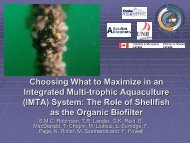Integrated multi-trophic aquaculture (IMTA) in marine temperate waters
Integrated multi-trophic aquaculture (IMTA) in marine temperate waters
Integrated multi-trophic aquaculture (IMTA) in marine temperate waters
Create successful ePaper yourself
Turn your PDF publications into a flip-book with our unique Google optimized e-Paper software.
<strong>Integrated</strong> <strong>multi</strong>-<strong>trophic</strong> <strong>aquaculture</strong> (<strong>IMTA</strong>) <strong>in</strong> mar<strong>in</strong>e <strong>temperate</strong> <strong>waters</strong> 29<br />
system has to work as a whole, there will be direct economic benefits flow<strong>in</strong>g to the<br />
community for keep<strong>in</strong>g the ecosystem healthy. In a practical sense, this means review<strong>in</strong>g<br />
<strong>in</strong>frastructure projects from an environmental po<strong>in</strong>t of view will be important to the<br />
town’s f<strong>in</strong>ances. The <strong>in</strong>creased cost of monitor<strong>in</strong>g and management should be more<br />
than made up by the returns from the local <strong>IMTA</strong> <strong>in</strong>dustry with their <strong>in</strong>creased value<br />
<strong>in</strong> food quality and safety.<br />
Develop<strong>in</strong>g bio-economic models for <strong>IMTA</strong> systems<br />
Chop<strong>in</strong> et al. (2001) demonstrated how <strong>in</strong>tegrat<strong>in</strong>g seaweeds (Gracilaria) with salmon<br />
farms can help <strong>in</strong>crease profits while <strong>in</strong>ternaliz<strong>in</strong>g environmental costs. Assum<strong>in</strong>g<br />
an average price for salmon of US$4.8 kg, Table 3 shows how salmon farm profits<br />
(at different production levels and stock<strong>in</strong>g densities, based on Chilean fish farms)<br />
<strong>in</strong>crease without <strong>in</strong>ternaliz<strong>in</strong>g the total environmental costs (scenario a) and present<br />
situation throughout the world). Assum<strong>in</strong>g the costs of effluent mitigation are US$6.4<br />
to 12.8/kg for nitrogen and US$2.6 to 3.8/kg for phosphorus (based on treatment<br />
costs <strong>in</strong> Swedish sewage treatment plants), scenario b) of Table 3 shows that, if laws or<br />
regulations were implemented to have <strong>aquaculture</strong> operations responsibly <strong>in</strong>ternaliz<strong>in</strong>g<br />
their environmental costs, a significant reduction of their profitability would occur.<br />
Scenario c) of Table 3 shows that by <strong>in</strong>tegrat<strong>in</strong>g the culture of the nutrient scrubber<br />
and commercial crop Gracilaria (at a conservative price of US$1 per kg [dry]), the<br />
environmental costs of waste discharges are significantly reduced and profitability is<br />
significantly <strong>in</strong>creased. Although profitability <strong>in</strong> Table 4 is not as high as <strong>in</strong> Table 5 <strong>in</strong><br />
the short term, it ga<strong>in</strong>s stability and susta<strong>in</strong>ability for the culture system and reduced<br />
environmental and economic risk <strong>in</strong> the long term, which should make f<strong>in</strong>anc<strong>in</strong>g easier<br />
to obta<strong>in</strong> (Brzeski and Newkirk, 1997).<br />
Another economic model us<strong>in</strong>g <strong>in</strong>tegrated salmon-mussel farms was developed by<br />
Whitmarsh, Cook and Black (2006) us<strong>in</strong>g base l<strong>in</strong>e data from farms on the west coast<br />
of Scotland. Table 5 shows that the NPV of a salmon-mussel <strong>IMTA</strong> system is greater<br />
than the comb<strong>in</strong>ed NPV of salmon and mussel monoculture, assum<strong>in</strong>g 20 percent<br />
greater production rate of mussels due to proximity to fish cages and a discount rate of<br />
8 percent. Enhanced mussel productivity translates <strong>in</strong>to a measurable f<strong>in</strong>ancial benefit,<br />
tABlE 4<br />
Scenarios for salmon monoculture versus kelp/mussel/salmon <strong>IMTA</strong> <strong>in</strong> the Bay of Fundy,<br />
Canada. Ten year run NPV discounted at 5 percent and 10 percent (<strong>in</strong> US$)<br />
Operation Discount rate Scenario 1<br />
(optimistic)<br />
Scenario 2<br />
(worst case)<br />
Scenario 3<br />
(<strong>in</strong>termediate)<br />
Salmon monoculture nPV at 5 % 8 146 477 50 848 2 664 112<br />
IMtA nPV at 5 % 8 906 435 674 850 3 296 037<br />
Salmon monoculture nPV at 10 % 6 885 181 -228 345 2 391 135<br />
IMtA nPV at 10 % 7 508 913 403 579 3 014 866<br />
Source: Ridler et al. (2007).<br />
tABlE 5<br />
F<strong>in</strong>ancial performance (<strong>in</strong> UK£) of salmon and mussel <strong>aquaculture</strong>, considered <strong>in</strong>dependently or<br />
<strong>in</strong> an <strong>IMTA</strong> system<br />
Indicator Salmon<br />
monoculture<br />
Mussel<br />
monoculture<br />
<strong>IMTA</strong> Integration<br />
benefits<br />
normal production<br />
(tonnes per annum)<br />
600 77 - 15.4<br />
Price<br />
(uK£ per tonne)<br />
1 900 1 100 - -<br />
Annualized<br />
equivalent cost<br />
(uK£ per tonne)<br />
1 723 583 - -<br />
nPV (uK£) 922 114 353 328 1 425 685 150 243<br />
Source: Whitmarsh, cook and Black (2006).



